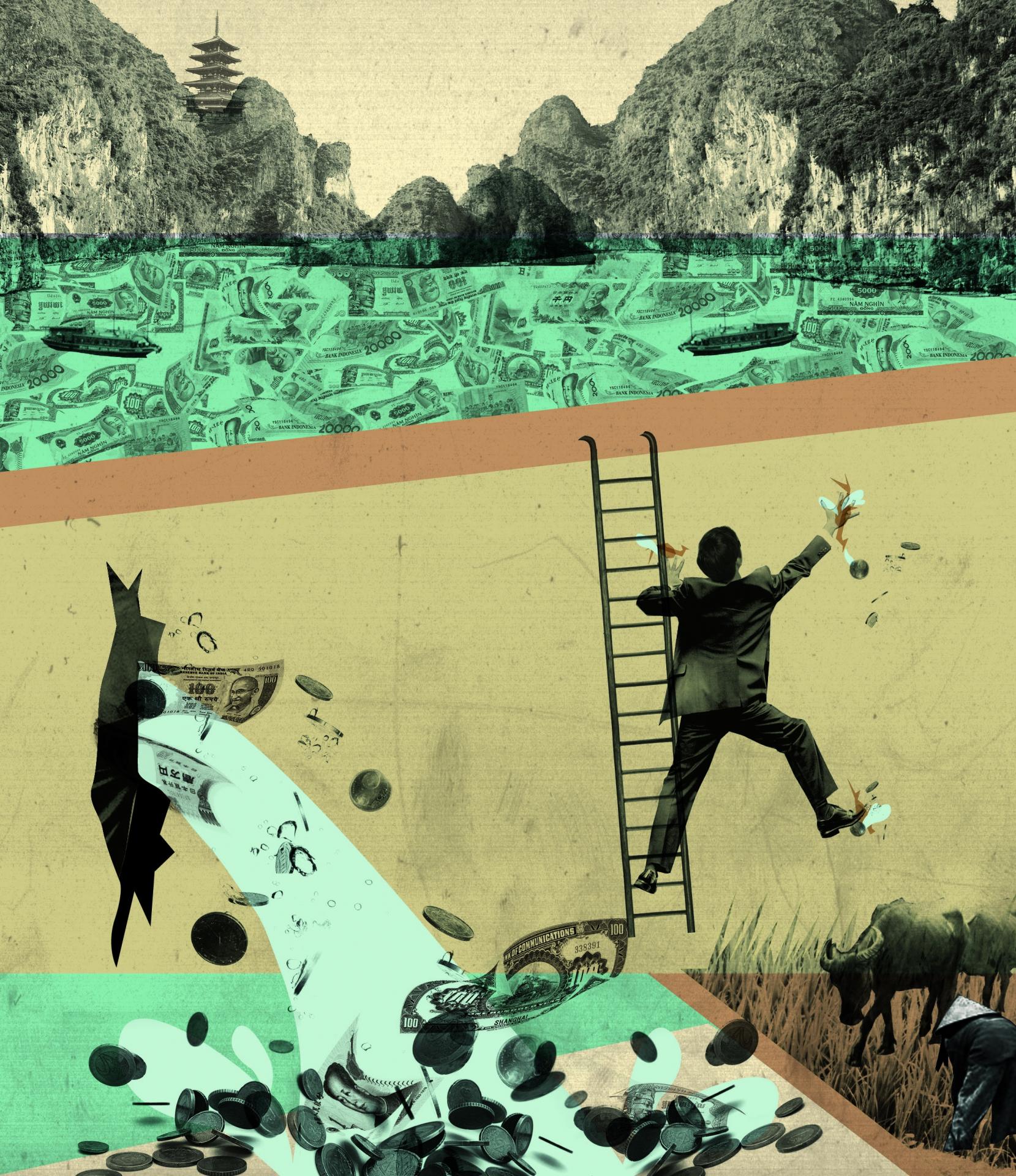I remember an evening many years ago, when my father was in charge of business affairs at a university in the Philippines. While I was having dinner with my family, a merchant came by our house and gave our cook two chickens to pass to my father.
I had never seen my father so upset. He stood up, took the chickens, and lambasted the merchant. He made it clear that the merchant would not be given a license to do business at the university. That incident introduced me to the complex world of corruption. My father went on to become a justice of the nation’s Supreme Court and constantly impressed upon us the importance of fighting corruption.
Corruption is like the Great Wall of China: it spans countless miles from east to west and the resources that most developing countries have are barely enough to break through even a small part of that wall. If tackling all aspects of corruption is insurmountable for developing countries, what’s the alternative?
I would argue that a country’s efforts should be strategically focussed on a specific areas, with the aim of leveraging successes elsewhere[1]. Given most developing countries’ scarce resources, they should identify which sectors have the greatest potential to promote rapid growth, what measures can be reasonably implemented given a state’s current capabilities, and asses whether anti-corruption incentives can be aligned to promote better implementation and increased compliance. In this manner, developing countries can prioritise both the sector and type of intervention necessary to combat corruption.

Strategic Focus
Combating corruption requires resources. Whether a state is trying to prevent corrupt activities or prosecuting accused corruptors, it needs people and money. For countries, economic growth is the primary source of income. Hence, the faster a country can grow, the more resources it can generate in its capacity to tackle corruption. It thus makes sense for a country to focus its limited resources on preventing corruption within a few high-growth areas. In many ways, this was the implicit strategy of the so-called ‘East Asian Miracle’ countries: Hong Kong, South Korea, Taiwan and Singapore
Historical evidence also suggests that governments begin to take anti-corruption efforts seriously when the middle class has become sufficiently large. When this happens, it means more people are better educated and care about public services. For example in 2011, tens of thousands of mainly middle-class people took part in anti-graft protests across India. As the general public becomes more demanding over standards of public amenities – such as schools, infrastructure and public safety – governments become more serious about reducing corruption[2].
How South Korea tackled corruption
In the 1960s and 1970s, South Korea adopted an export-driven strategy of economic development. President Park Chung-hee met monthly with business enterprises and government agencies to assess the performance of the enterprises in terms of export expansion. These were known as the ‘monthly export promotion meetings[3]’ and government-subsidised loans were provided to those enterprises that met their export targets.
At these meetings, South Korean enterprises were able to openly discuss any problems that they confronted in expanding their export capacity. Government agencies were tasked with addressing those issues, and were held accountable for doing so. Given the openness among participants at the monthly export promotion meetings, it is highly likely that corruption-related issues would have been addressed.
President Park was a principled man whose primary interest was to build South Korea’s manufacturing capability. It is likely that his participation in the monthly meetings led to the export sector being ‘sterilised’ of corruption – a far cry from the South Korea of the early 1960s, when corruption was much more rampant. Meanwhile, South Korea’s export sector, which Park is widely credited with reviving, would play a significant role in the country’s economic boom.
Policies vs. capacity
Partly because of international pressure, many low-income countries introduce anti-corruption policies and create institutions that mimic those in wealthier countries[4]. However, many developing countries do not have the capacity to implement these policies or maintain institutions.
For example, many low-income countries have introduced tax evasion laws with severe penalties. Unfortunately, their national tax agencies often cannot attract sufficient talent to undertake effective audits or successfully prosecute tax evaders. In such instances, it may be better to simplify the tax code so that even a high school-level educated official would be capable of spotting tax evasion, and penalties can be imposed without the need to go to litigation. The simpler the tax code, the less demanding are the skills needed to combat tax evasion, as Vietnam showed in 2011 when it introduced policies to make the administration of taxes more transparent and simpler to understand.
Aligning incentives
Corruption often plagues essential public services. This is in part because government employees are not well paid enough, and in part because governments tend to introduce cumbersome regulations to compensate for skills deficiency. This then creates opportunities to extract bribes from those seeking government service.
In one particular developing country, the immigration agency was fraught with corruption. Individuals who could rightfully seek residency had to go through a complex web of procedures to obtain immigration papers. This led to the emergence of so-called ‘brokers’ who facilitated the issuance of papers – in exchange for a hefty fee (which was shared with agency employees).
A new head of this agency was appointed, and she decided to change things. The new head scrapped many procedures and introduced a reward-based system dependent on the number of papers processed monthly. This led to a remarkable turnaround. Service improved dramatically and employees began to focus on efficiency-enhancing measures. The agency slowly became a role model, and corruption practically disappeared.
Unfortunately, politicians in that country began to worry. The head of the agency had become increasingly popular, and some politicians feared that she could become a political threat to them. They argued that civil servants should be paid equally, so the agency was arguably violating civil service law. So, although incentives were better aligned with service, this experiment came to an unfortunate end.
Pragmatic measures
The concept of a single pay structure for civil servants comes largely from more developed countries, who can afford to pay civil servants reasonably well. From a practical approach to fighting corruption this poses a dilemma: what happens when processes or regulations clash with the strategic approach of tackling corruption in priority sectors?
If a country focuses on anti-corruption in select areas, then it may well have to offer higher compensation to civil servants in agencies that have significant influence over these areas. This allows the country to align incentives better with improved delivery of services by these agencies. Unfortunately, theory often runs orthogonal to practicality.
I moved from investment banking to development banking because of my deep interest in helping alleviate poverty in the developing world. I quickly realised that corruption cannot be disentangled from the process of development. There will always be vested interests that seek to corrupt systems and processes. It is understandable why many well-meaning individuals and groups advocate for zero tolerance for corruption: they see corruption permeate daily life and impede progress on many fronts.
Such groups keep awareness of corruption on society’s radar. However, to effectively curb corruption, pragmatism must rule the day. Those vested interests need to be managed tactically, skilfully and patiently in order that corruption can be tackled incrementally.
The views expressed in this article are solely those of the author and not of the World Bank, the World Bank Institute, or any other organisation he has been engaged with.
Jose Edgardo Campos is a manager in the Leadership Practice at the World Bank Institute.
End notes
2. See for instance Haggard, Stephan, Pathways From the Periphery: The Politics of Growth in the Newly Industrializing Countries, Cornell University Press, 1990.
3. South Korea once again offers a good example. In the 1960s, it was considered a very corrupt country. But through the decades, rapid growth spurred the development of a large middle class which then became the driving force towards democracy. Along the way, two former “strong man” Presidents were incarcerated on corruption charges. And, as it the country emerged as a technology powerhouse, the government infused modern information technology into its operations to reduce human contact between government service providers and citizens, increase transparency, promote greater efficiency.
4. For a more general argument, see Andrews, Pritchett, and Woolcock, “Capability Traps? The Mechanisms of Persistent Implementation Failure,” Center for Global Development, Working Paper 234, December 2010.
This article was first published in HQ Asia (Print) Issue 06 (2013)


